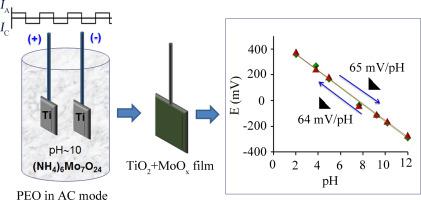当前位置:
X-MOL 学术
›
J. Electroanal. Chem.
›
论文详情
Our official English website, www.x-mol.net, welcomes your
feedback! (Note: you will need to create a separate account there.)
Anodic-cathodic formation of pH-sensitive TiO2-MoOx films on titanium
Journal of Electroanalytical Chemistry ( IF 4.1 ) Pub Date : 2020-09-01 , DOI: 10.1016/j.jelechem.2020.114388 Marina S. Vasilyeva , Irina V. Lukiyanchuk , Alexander Yu. Ustinov , Elena V. Shchitovskaya , Galina I. Marinina
Journal of Electroanalytical Chemistry ( IF 4.1 ) Pub Date : 2020-09-01 , DOI: 10.1016/j.jelechem.2020.114388 Marina S. Vasilyeva , Irina V. Lukiyanchuk , Alexander Yu. Ustinov , Elena V. Shchitovskaya , Galina I. Marinina

|
Abstract A new type of solid-state metal-oxide pH sensor based on TiO2-MoOx films on titanium has been fabricated by plasma electrolytic oxidation in the anodic-cathodic mode. The structural features of the films have been investigated by scanning electron microscopy (SEM), X-ray diffraction (XRD) and X-ray photoelectron spectroscopy (XPS). According to XPS, the surface layers of the resulting films contain up to 5 at.% Mo in the form of oxides (MoO3, Mo2O5 or Mo4O11) and the near-surface layers additionally contain MoO2. The potentiometric pH response of the TiO2-MoOx electrode reveals near-Nernstian behavior, i.e. a linear working range from pH 2 to 12 with a slope of about 64 ± 2 mV/pH. The mixed films are characterized by very fast response time in alkali and acids solutions shorter than 5 s. The response is not affected by the direction of the pH change and the presence of K+ and Na+ ions. The resulting electrodes have been tested as pH sensors in acid-base titration. The relative error in the determination of NaOH using Ti/TiO2-MoOx electrode does not exceed 2.5%. The possibility of using electrodes based on TiO2-MoOx films to accurately determine the alkalinity of industrial waters is shown. In addition, this sensor offers some analytical characteristics, such as high sensitivity, good reproducibility and simple preparation procedure. Compared to a glass electrode, the Ti/TiO2-MoOx electrode has several advantages, including low cost and high stability.
中文翻译:

在钛上阳极-阴极形成 pH 敏感的 TiO2-MoOx 薄膜
摘要 通过阳极-阴极模式下的等离子体电解氧化制备了一种基于钛表面TiO2-MoOx薄膜的新型固态金属氧化物pH传感器。通过扫描电子显微镜 (SEM)、X 射线衍射 (XRD) 和 X 射线光电子能谱 (XPS) 研究了薄膜的结构特征。根据 XPS,所得薄膜的表面层含有高达 5at.% 的氧化物(MoO3、Mo2O5 或 Mo4O11)形式的 Mo,近表面层还含有 MoO2。TiO2-MoOx 电极的电位 pH 响应显示出接近 Nernstian 的行为,即从 pH 2 到 12 的线性工作范围,斜率约为 64 ± 2 mV/pH。混合薄膜的特点是在碱和酸溶液中的响应时间非常快,不到 5 秒。响应不受 pH 变化方向以及 K+ 和 Na+ 离子的影响。所得电极已在酸碱滴定中作为 pH 传感器进行测试。使用 Ti/TiO2-MoOx 电极测定 NaOH 的相对误差不超过 2.5%。显示了使用基于 TiO2-MoOx 薄膜的电极来准确确定工业用水碱度的可能性。此外,该传感器还具有一些分析特性,例如高灵敏度、良好的重现性和简单的制备程序。与玻璃电极相比,Ti/TiO2-MoOx 电极具有几个优点,包括低成本和高稳定性。使用 Ti/TiO2-MoOx 电极测定 NaOH 的相对误差不超过 2.5%。显示了使用基于 TiO2-MoOx 薄膜的电极来准确确定工业用水碱度的可能性。此外,该传感器还具有一些分析特性,例如高灵敏度、良好的重现性和简单的制备程序。与玻璃电极相比,Ti/TiO2-MoOx 电极具有几个优点,包括低成本和高稳定性。使用 Ti/TiO2-MoOx 电极测定 NaOH 的相对误差不超过 2.5%。显示了使用基于 TiO2-MoOx 薄膜的电极来准确确定工业用水碱度的可能性。此外,该传感器还具有一些分析特性,例如高灵敏度、良好的重现性和简单的制备程序。与玻璃电极相比,Ti/TiO2-MoOx 电极具有几个优点,包括低成本和高稳定性。
更新日期:2020-09-01
中文翻译:

在钛上阳极-阴极形成 pH 敏感的 TiO2-MoOx 薄膜
摘要 通过阳极-阴极模式下的等离子体电解氧化制备了一种基于钛表面TiO2-MoOx薄膜的新型固态金属氧化物pH传感器。通过扫描电子显微镜 (SEM)、X 射线衍射 (XRD) 和 X 射线光电子能谱 (XPS) 研究了薄膜的结构特征。根据 XPS,所得薄膜的表面层含有高达 5at.% 的氧化物(MoO3、Mo2O5 或 Mo4O11)形式的 Mo,近表面层还含有 MoO2。TiO2-MoOx 电极的电位 pH 响应显示出接近 Nernstian 的行为,即从 pH 2 到 12 的线性工作范围,斜率约为 64 ± 2 mV/pH。混合薄膜的特点是在碱和酸溶液中的响应时间非常快,不到 5 秒。响应不受 pH 变化方向以及 K+ 和 Na+ 离子的影响。所得电极已在酸碱滴定中作为 pH 传感器进行测试。使用 Ti/TiO2-MoOx 电极测定 NaOH 的相对误差不超过 2.5%。显示了使用基于 TiO2-MoOx 薄膜的电极来准确确定工业用水碱度的可能性。此外,该传感器还具有一些分析特性,例如高灵敏度、良好的重现性和简单的制备程序。与玻璃电极相比,Ti/TiO2-MoOx 电极具有几个优点,包括低成本和高稳定性。使用 Ti/TiO2-MoOx 电极测定 NaOH 的相对误差不超过 2.5%。显示了使用基于 TiO2-MoOx 薄膜的电极来准确确定工业用水碱度的可能性。此外,该传感器还具有一些分析特性,例如高灵敏度、良好的重现性和简单的制备程序。与玻璃电极相比,Ti/TiO2-MoOx 电极具有几个优点,包括低成本和高稳定性。使用 Ti/TiO2-MoOx 电极测定 NaOH 的相对误差不超过 2.5%。显示了使用基于 TiO2-MoOx 薄膜的电极来准确确定工业用水碱度的可能性。此外,该传感器还具有一些分析特性,例如高灵敏度、良好的重现性和简单的制备程序。与玻璃电极相比,Ti/TiO2-MoOx 电极具有几个优点,包括低成本和高稳定性。











































 京公网安备 11010802027423号
京公网安备 11010802027423号